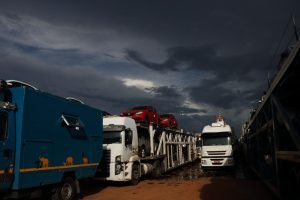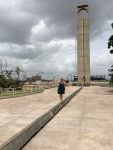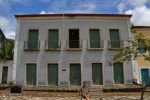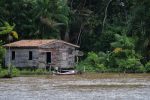You can’t just drive across the Amazon Delta you know… you’d get a bit wet. Cuthbert earned his ‘Water-fording Proficiency’ badge reaching the Lençóis Maranhenses but this time we need to put him on a barge which zig-zags over 38 hours between the mangroves and islands, crossing the Amazon Delta. Compared to the much travelled western side of the continent, this north-eastern route of South America is, even in the dry season, relatively little trodden by the ‘overlanding community’. In the currently prevailing rainy season, even fewer travellers venture up here. Hmmm… maybe there’s a good reason for that!! 
Anticipating hurdles
We’re heading west along the coast of Brazil to the city of Belem on the southern edge of the Amazon Delta. Our border crossing into French Guiana is looming and as we go we’re learning of a few practical issues we’ll be facing over the coming weeks.
We thought the first hurdle might be arranging the boat to cross the Delta, but in fact it turned out to be the battle with the Belem traffic. Belem will go down in Tuck’s Tuck folklore as our most congested city in Brazil, in fact in the whole of South America! Not since Kampala in Uganda have we tackled traffic-jams quite like this. We have a few admin things to sort out before we sail (in particular a massive pile of laundry) but ‘just nipping’ even the shortest distances around Belem takes literally hours in the traffic.
Next hurdle will be sailing across the Delta, then we have the drive up to the French Guiana border. It’s around 600km and we’ve recently heard that only part of the route is surfaced. The rest is dirt road and at this rainy-season time of year, it’s likely to be muddy and tough going. Oh well… we are (cautiously) confident in Cuthbert’s capability!
For the border-crossing to French Guiana we had, until recently, expected another hurdle and an expensive one at that! Some years ago a bridge was built over the border Rio Oiapoque but, due to some political shenanigan or other, it didn’t open.
Despite a majestically modern new bridge spanning the river, all crossings were by a local ferry carrier who charged a barkingly ridiculous US$250 for a 5 minute crossing!! This price could be shared if you were lucky enough to find anyone else wanting to do the trip, but it’s not a much-travelled route… so good luck with that! Anyway… just a couple of weeks ago we learned by the wizardry of the inter-web that some deal had been reached and the bridge has finally opened!!! We couldn’t believe our luck! If they can just manage to keep it open until we get there, we’ll save a whopping ferry fee!
Another hurdle that popped-up ‘out of the blue’ is some major strike disruption in French Guiana. International news tells of disgruntled bunnies trying to stall the country with road blockades and labour stoppages. As Brits we find the situation mildly amusing… we’ve seen so many French port workers’ strikes causing havoc crossing the English Channel, and air traffic controllers causing mayhem across the European airways, it seems only fitting that this fine tradition of French disruption should continue in their overseas territories . As I write this, French Ministers are apparently on their way out to Cayenne for talks, so hopefully it will all be resolved by the time we… let’s be optimistic here… cross the bridge.
 But we’re getting ahead of ourselves a bit now. We first need to get to the river! On our way to Belem on south side of the Amazon Delta we pass through the historic towns of Sao Luis and Alcantara. They’re not exactly on the mass tourist-trail, but they hold some interest. Due to the prevailing climate here, these towns are ‘famous’ for the tiled facades on the buildings preventing them from becoming mouldy and black with the humidity.
But we’re getting ahead of ourselves a bit now. We first need to get to the river! On our way to Belem on south side of the Amazon Delta we pass through the historic towns of Sao Luis and Alcantara. They’re not exactly on the mass tourist-trail, but they hold some interest. Due to the prevailing climate here, these towns are ‘famous’ for the tiled facades on the buildings preventing them from becoming mouldy and black with the humidity.
 A curious sight along the roadside is water-buffalo in the paddy fields. These aren’t indigenous to South America at all; they’re thought to be descendants of buffalos which escaped from a sinking ship on its way from India to French Guiana many years ago. Can’t complain about a lack of useless trivia here can you?
A curious sight along the roadside is water-buffalo in the paddy fields. These aren’t indigenous to South America at all; they’re thought to be descendants of buffalos which escaped from a sinking ship on its way from India to French Guiana many years ago. Can’t complain about a lack of useless trivia here can you?
Crossing the Amazon Delta
 So… from the congested town of Belem we take to the water. Cuthbert is too big for the car ferry, so we need to go with the commercial trucks on a freight barge. We find a freighting agent and resort once again to the modern gadgetry of Google Translate to make ourselves understood. He seems friendly enough, but isn’t one for trivial formalities like paperwork. He glances at Cuthbert and gives us an extortionate verbal quote, so we barter him down, hand over the cash and keep our fingers crossed!
So… from the congested town of Belem we take to the water. Cuthbert is too big for the car ferry, so we need to go with the commercial trucks on a freight barge. We find a freighting agent and resort once again to the modern gadgetry of Google Translate to make ourselves understood. He seems friendly enough, but isn’t one for trivial formalities like paperwork. He glances at Cuthbert and gives us an extortionate verbal quote, so we barter him down, hand over the cash and keep our fingers crossed!
 Two days later, despite the lack of paperwork, it all comes good when we report to a very rough-looking freight yard to board the barge. Cuthbert is very much the baby passenger sitting amongst the huge multi-tier car transporters and articulated mega-trucks. Loading the barge turns out to be a surprisingly less than slick operation, but during the three hour delay we find the friendly truck drivers are already taking us under their wing. They introduce themselves, take us to the on-board drivers’ diner, offer us beer and wine from their trucks and generally make us feel like one of the team. There are only six other drivers sailing with their trucks (most of the cargo is on dropped-off trailers), but they are all so nice to us. Shouldn’t be a surprise really, this just reflects the warm welcome we have received all over Brazil.
Two days later, despite the lack of paperwork, it all comes good when we report to a very rough-looking freight yard to board the barge. Cuthbert is very much the baby passenger sitting amongst the huge multi-tier car transporters and articulated mega-trucks. Loading the barge turns out to be a surprisingly less than slick operation, but during the three hour delay we find the friendly truck drivers are already taking us under their wing. They introduce themselves, take us to the on-board drivers’ diner, offer us beer and wine from their trucks and generally make us feel like one of the team. There are only six other drivers sailing with their trucks (most of the cargo is on dropped-off trailers), but they are all so nice to us. Shouldn’t be a surprise really, this just reflects the warm welcome we have received all over Brazil.
 The barge is a large single-deck open platform carrying around 20 large trucks (plus Cuthbert). The platform is hooked-up to a shunting boat which pushes it down the waterways around 550km over 38 hours. Everyone sleeps in their trucks and there is a small galley/diner on the shunting boat serving basic but tasty meals. The galley is adjacent to the engine room, so it’s hellish noisy and there’s no chance for conversation over meals. Most of the time we spend out in the peace of the deck, socialising with the truck drivers. In between the torrential down-pours (yup… did we mention it’s rainy season here?). Marcus makes manages to gain even more favour with our fellow passengers by fixing an electrical connection on one of the trucks and jump-starting another one with a flat battery.
The barge is a large single-deck open platform carrying around 20 large trucks (plus Cuthbert). The platform is hooked-up to a shunting boat which pushes it down the waterways around 550km over 38 hours. Everyone sleeps in their trucks and there is a small galley/diner on the shunting boat serving basic but tasty meals. The galley is adjacent to the engine room, so it’s hellish noisy and there’s no chance for conversation over meals. Most of the time we spend out in the peace of the deck, socialising with the truck drivers. In between the torrential down-pours (yup… did we mention it’s rainy season here?). Marcus makes manages to gain even more favour with our fellow passengers by fixing an electrical connection on one of the trucks and jump-starting another one with a flat battery.
 As it’s river sailing, the going is very smooth and as we glide past the Amazon riverside communities, local children paddle out to us in their kayaks. The kids are little more than tiny-tots but they skilfully manoeuvre alongside the barge (we were doing 7.6kts/14kph!!) tie-up and climb on-board to collect sweets and biscuits from the truck drivers.
As it’s river sailing, the going is very smooth and as we glide past the Amazon riverside communities, local children paddle out to us in their kayaks. The kids are little more than tiny-tots but they skilfully manoeuvre alongside the barge (we were doing 7.6kts/14kph!!) tie-up and climb on-board to collect sweets and biscuits from the truck drivers.
 Our disembarkation point is a teeny smidgeon south of the Equator sitting at 00°00’09.11S. Down the road in Macapa is a monument on the Equator which, of course, we have to visit for the obligatory cheesy photo with one foot in each hemisphere. Next to the monument is a football stadium where the centre-line runs exactly along the Equator, so the teams each kick-off from a different hemisphere!
Our disembarkation point is a teeny smidgeon south of the Equator sitting at 00°00’09.11S. Down the road in Macapa is a monument on the Equator which, of course, we have to visit for the obligatory cheesy photo with one foot in each hemisphere. Next to the monument is a football stadium where the centre-line runs exactly along the Equator, so the teams each kick-off from a different hemisphere!
View from the Bridge
From Macapa to the French Guiana border is a pretty dull 600km drive and turns out to be nothing like the challenging hurdle that we had expected. There are around 200km of dirt-road but even after heavy rains the surface is very firm. There are a few nasty pot-holes (well quite a lot of them really) but any vehicle can tackle them if they take it steady. At the end of all this we reach the Oiapoque River to see the majestic and (until recently) un-crossable bridge.
French Guiana is an overseas department of France and bizarrely, it’s technically part of the EU. It’s in sight from Brazil… but can we drive there? We’ve heard various stories from overlanders about the crazy ferry prices that we didn’t dare hope for the bridge to still be open when we arrived, but we’re in luck… our path to Europe is open!! There must surely be a Brexit joke in there somewhere, but can’t think of one right now
We’ll have to return to Brazil at some point as there is no other land exit route, but looking back from the bridge over the last two months (and over 9,500km) in Brazil, how has it been?
First, we have been gob-smacked by how genuinely friendly and welcoming the people are. Nowhere else in South America have we received such an enthusiastic welcome as in Brazil. Cuthbert is a star here and locals seem to love him. We’ve lost count of the number of drivers giving us toots and thumbs-up on the road and the many people coming to say hello, take selfies and ask questions.
Due to the limited time of our entry permit we’ve had to take a faster pace through Brazil than we would otherwise have taken. However, we did manage to explore a bit and found that Brazil has a few surprises up its sleeve, our personal highlights have been some lesser known places such as Parque Jalapão in Tocantins State and Lençóis Maranhenses in Maranhão.
Communication has been an issue for us here. Knowledge of Spanish helps with Portugese up to a point and smiles go a long way but if all else fails, our fall-back plan is to cheat with the hi-tech solution of Google Translate on the smart-phone. The translations do sometimes produce mildly amusing results, but you can usually get the gist.
One observation from Brazil that we really must mention is their obsession with flip-flops. Men, women, young, old, all wear flip-flops and they are sold literally everywhere. Never previously known to be a flip-flop kind of chap, even Marcus has bought some here! Big-name brands such as Havaianna and Ipanema have their own dedicated stores exclusively for flip-flops, but flip-flop selling isn’t limited to these or even to the more general shoe shops… oh no. Flip-flops are sold in chemists, hard-ware shops, food-stores, news-stands, petrol stations, you name it! At no time in Brazil need one be without a flip-flop to coordinate with one’s attire… every style, shape and colour is catered for… anywhere!
Anyway… Brazil so far has been marvellous and we look forward to coming back, but for the time being… we’re off to France!
Link to next blog: French Guiana… bonjour! Link to full South America Blog
Amazon Delta – Picture Gallery
- Children









































